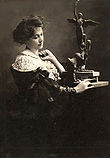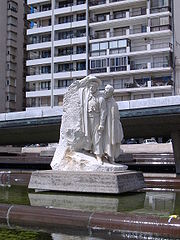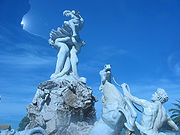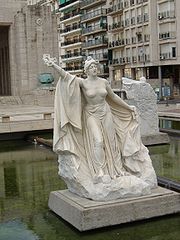
Lola Mora
Encyclopedia

Sculpture
Sculpture is three-dimensional artwork created by shaping or combining hard materials—typically stone such as marble—or metal, glass, or wood. Softer materials can also be used, such as clay, textiles, plastics, polymers and softer metals...
, born in a barn in the , though generally considered native to Trancas, province of Tucumán
Tucumán Province
Tucumán is the most densely populated, and the smallest by land area, of the provinces of Argentina. Located in the northwest of the country, the capital is San Miguel de Tucumán, often shortened to Tucumán. Neighboring provinces are, clockwise from the north: Salta, Santiago del Estero and...
, where she was recorded and baptized. She is known today as a rebel and a pioneer of women in her artistic field. Her real name was Dolores Mora Vega.
Lola Mora was the daughter of Romualdo Alejandro Mora, a prosperous landowner of Tucumán. She was also a goddaughter of Nicolás Avellaneda
Nicolás Avellaneda
Nicolás Remigio Aurelio Avellaneda Silva was an Argentine politician and journalist, and president of Argentina from 1874 to 1880. Avellaneda's main projects while in office were banking and education reform, leading to Argentina's economic growth...
and a protégé of Julio Argentino Roca
Julio Argentino Roca
Alejo Julio Argentino Roca Paz was an army general who served as President of Argentina from 12 October 1880 to 12 October 1886 and again from 12 October 1898 to 12 October 1904.-Upbringing and early career:...
.


Portrait
thumb|250px|right|Portrait of [[Thomas Jefferson]] by [[Rembrandt Peale]], 1805. [[New-York Historical Society]].A portrait is a painting, photograph, sculpture, or other artistic representation of a person, in which the face and its expression is predominant. The intent is to display the likeness,...
s, but soon turned to sculpting marble
Marble
Marble is a metamorphic rock composed of recrystallized carbonate minerals, most commonly calcite or dolomite.Geologists use the term "marble" to refer to metamorphosed limestone; however stonemasons use the term more broadly to encompass unmetamorphosed limestone.Marble is commonly used for...
and granite
Granite
Granite is a common and widely occurring type of intrusive, felsic, igneous rock. Granite usually has a medium- to coarse-grained texture. Occasionally some individual crystals are larger than the groundmass, in which case the texture is known as porphyritic. A granitic rock with a porphyritic...
. She studied art in her home province and then, with a scholarship, in Rome
Rome
Rome is the capital of Italy and the country's largest and most populated city and comune, with over 2.7 million residents in . The city is located in the central-western portion of the Italian Peninsula, on the Tiber River within the Lazio region of Italy.Rome's history spans two and a half...
, Italy
Italy
Italy , officially the Italian Republic languages]] under the European Charter for Regional or Minority Languages. In each of these, Italy's official name is as follows:;;;;;;;;), is a unitary parliamentary republic in South-Central Europe. To the north it borders France, Switzerland, Austria and...
, where she created her greatest works, some of them by request of the Argentine government. In 1900 she was charged with creating two bas-reliefs for the Historical House of Tucumán (seat of Argentina's Declaration of Independence of 1816).
Her style and exposure were controversial and rebellious. In 1903 her The Nereids Fountain, created for the city of Buenos Aires
Buenos Aires
Buenos Aires is the capital and largest city of Argentina, and the second-largest metropolitan area in South America, after São Paulo. It is located on the western shore of the estuary of the Río de la Plata, on the southeastern coast of the South American continent...
, met bureaucratic problems at the city's Deliberative Council, which had the sculpture moved from place to place.
Near the end of her life, she did some extravagant business (such as financing petroleum
Petroleum
Petroleum or crude oil is a naturally occurring, flammable liquid consisting of a complex mixture of hydrocarbons of various molecular weights and other liquid organic compounds, that are found in geologic formations beneath the Earth's surface. Petroleum is recovered mostly through oil drilling...
surveys in Salta
Salta Province
Salta is a province of Argentina, located in the northwest of the country. Neighboring provinces are from the east clockwise Formosa, Chaco, Santiago del Estero, Tucumán and Catamarca. It also surrounds Jujuy...
), and then retired with only a pension
Pension
In general, a pension is an arrangement to provide people with an income when they are no longer earning a regular income from employment. Pensions should not be confused with severance pay; the former is paid in regular installments, while the latter is paid in one lump sum.The terms retirement...
to support herself. After her death in Buenos Aires, in poverty and obscurity, friends of hers burned her letters, mementos and personal diaries.
Although it is not commonly known, Lola Mora obtained various patents. One included a system to project film
Film
A film, also called a movie or motion picture, is a series of still or moving images. It is produced by recording photographic images with cameras, or by creating images using animation techniques or visual effects...
s without a screen (using a column of vapor
Vapor
A vapor or vapour is a substance in the gas phase at a temperature lower than its critical point....
), as well as systems for mining
Mining
Mining is the extraction of valuable minerals or other geological materials from the earth, from an ore body, vein or seam. The term also includes the removal of soil. Materials recovered by mining include base metals, precious metals, iron, uranium, coal, diamonds, limestone, oil shale, rock...
.
Works

- The above mentioned bass-reliefs at the House of Tucumán, with the themes of the May RevolutionMay RevolutionThe May Revolution was a week-long series of events that took place from May 18 to 25, 1810, in Buenos Aires, capital of the Viceroyalty of the Río de la Plata, a Spanish colony that included roughly the territories of present-day Argentina, Bolivia, Paraguay and Uruguay...
's First National Government and the Declaration of Independence. - A Statue of Liberty, also in San Miguel de Tucumán.
- The The Nereids Fountain, now located at Costanera Sur, Buenos Aires, and the Avellaneda Memorial.
- Several sculpture groups placed in the historic center of RosarioRosarioRosario is the largest city in the province of Santa Fe, Argentina. It is located northwest of Buenos Aires, on the western shore of the Paraná River and has 1,159,004 residents as of the ....
, flanking the way to the propylaeum of the National Flag MemorialNational Flag Memorial (Argentina)The National Flag Memorial in Rosario, Argentina, is a monumental complex built near the shore of the Paraná River...
. - Four allegoricAllegoryAllegory is a demonstrative form of representation explaining meaning other than the words that are spoken. Allegory communicates its message by means of symbolic figures, actions or symbolic representation...
sculptures called Peace, Justice, Liberty and Progress, originally created for the National Congress building, but then placed around the building of the Government House of San Salvador de JujuySan Salvador de JujuySan Salvador de Jujuy , commonly known as Jujuy and locally often referred to as San Salvador, is the capital city of Jujuy Province in northwest Argentina. It lies near the southern end of the Humahuaca Canyon where wooded hills meet the lowlands....
.
Sources
- VisiteTuc.com - A site about Tucumán.
- Practicosas.com.ar - A women's site with a romantic biography.
- Municipality of Jujuy - Official website.
- Universidad Nacional de Rosario - Pictures of the Oath Passage in Rosario, flanked by Lola Mora's sculptures.

